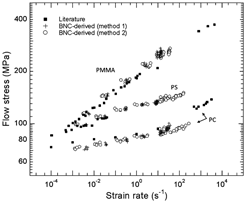Crossref Citations
This article has been cited by the following publications. This list is generated based on data provided by
Crossref.
Jakes, Joseph E.
Lakes, Rod S.
and
Stone, Don S.
2012.
Broadband nanoindentation of glassy polymers: Part I. Viscoelasticity.
Journal of Materials Research,
Vol. 27,
Issue. 2,
p.
463.
Wang, Fei
Jakes, Joseph E.
Geng, Dalong
and
Wang, Xudong
2013.
Spontaneous Phase Transformation and Exfoliation of Rectangular Single-Crystal Zinc Hydroxy Dodecylsulfate Nanomembranes.
ACS Nano,
Vol. 7,
Issue. 7,
p.
6007.
Ago, Mariko
Jakes, Joseph E.
and
Rojas, Orlando J.
2013.
Thermomechanical Properties of Lignin-Based Electrospun Nanofibers and Films Reinforced with Cellulose Nanocrystals: A Dynamic Mechanical and Nanoindentation Study.
ACS Applied Materials & Interfaces,
Vol. 5,
Issue. 22,
p.
11768.
Zadeh, Amirreza Sanaty
Xia, Xiangyu
Luo, Alan A.
Jakes, Joseph E.
and
Stone, Donald S.
2013.
Magnesium Technology 2013.
p.
27.
Park, Byung-Dae
Frihart, Charles R.
Yu, Yan
and
Singh, Adya P.
2013.
Hardness evaluation of cured urea–formaldehyde resins with different formaldehyde/urea mole ratios using nanoindentation method.
European Polymer Journal,
Vol. 49,
Issue. 10,
p.
3089.
Zadeh, Amirreza Sanaty
Xia, Xiangyu
Luo, Alan A.
Jakes, Joseph E.
and
Stone, Donald S.
2013.
Magnesium Technology 2013.
p.
27.
Herbert, Erik G.
Sudharshan Phani, P.
and
Johanns, Kurt E.
2015.
Nanoindentation of viscoelastic solids: A critical assessment of experimental methods.
Current Opinion in Solid State and Materials Science,
Vol. 19,
Issue. 6,
p.
334.
Olson, Isabel A
Shtukenberg, Alexander G
Kahr, Bart
and
Ward, Michael D
2018.
Dislocations in molecular crystals.
Reports on Progress in Physics,
Vol. 81,
Issue. 9,
p.
096501.
Stegall, D. E.
and
Elmustafa, A. A.
2018.
The Contribution of Dislocation Density and Velocity to the Strain Rate and Size Effect Using Transient Indentation Methods and Activation Volume Analysis.
Metallurgical and Materials Transactions A,
Vol. 49,
Issue. 10,
p.
4649.
Hunt, Christopher G.
Frihart, Charles R.
Dunky, Manfred
and
Rohumaa, Anti
2019.
Progress in Adhesion and Adhesives.
p.
353.
Ma, Yi
Huang, Xianwei
Song, Yuxuan
Hang, Wei
and
Zhang, Taihua
2019.
Room-Temperature Creep Behavior and Activation Volume of Dislocation Nucleation in a LiTaO3 Single Crystal by Nanoindentation.
Materials,
Vol. 12,
Issue. 10,
p.
1683.
Jakes, Joseph E.
and
Stone, Donald S.
2021.
Best Practices for Quasistatic Berkovich Nanoindentation of Wood Cell Walls.
Forests,
Vol. 12,
Issue. 12,
p.
1696.
Fulco, Sage
Wolf, Sarah
Jakes, Joseph E.
Fakhraai, Zahra
and
Turner, Kevin T.
2021.
Effect of surface detection error due to elastic–plastic deformation on nanoindentation measurements of elastic modulus and hardness.
Journal of Materials Research,
Vol. 36,
Issue. 11,
p.
2176.
Jakes, Joseph E.
and
Stauffer, Douglas
2021.
Contact area correction for surface tilt in pyramidal nanoindentation.
Journal of Materials Research,
Vol. 36,
Issue. 11,
p.
2189.
Rueda-Ruiz, Mario
Beake, Ben D.
and
Molina-Aldareguia, Jon M.
2022.
Determination of Rate-Dependent Properties in Cohesive Frictional Materials by Instrumented Indentation.
JOM,
Vol. 74,
Issue. 6,
p.
2206.
Christoefl, P.
Jakes, J. E.
Geier, J.
Pinter, G.
Oreski, G.
Stone, D.
and
Teichert, C.
2023.
Improved nanoindentation methods for polymer based multilayer film cross-sections.
p.
1.
Erazo, Oswaldo
Jakes, Joseph E.
Plaza, Nayomi Z.
Vergara-Figueroa, Judith
Valenzuela, Paulina
and
Gacitúa, William
2023.
Quasistatic and Dynamic Nanoindentation Measurements of Pinus radiata D. Don S2 and CCML Cell Wall Layers.
Forests,
Vol. 14,
Issue. 9,
p.
1900.
Jakes, Joseph E.
O’dell, Jane
and
Stone, Donald S.
2024.
Viscoelastic Moduli and Path-Dependent Hardness Across Four Decades of Timescale in Semicrystalline Polymers from Berkovich Nanoindentation.
JOM,
Vol. 76,
Issue. 6,
p.
2956.
Stone, D. S.
Jakes, J. E.
and
Elmustafa, A. A.
2024.
A Well-Posed Definition for Plastic Strain Rate in Indentation.
JOM,
Vol. 76,
Issue. 6,
p.
2946.





